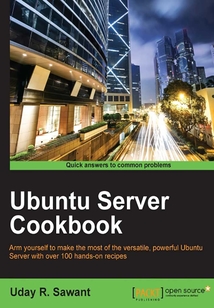舉報 

會員
Ubuntu Server Cookbook
Uday R. Sawant 著
更新時間:2021-07-14 11:22:39
開會員,本書免費讀 >
最新章節:
Index
UbuntuServerCookbookisforsystemadministratorsorsoftwaredeveloperswithabasicunderstandingoftheLinuxoperatingsystemwhowanttosetuptheirownservers.Youarenotrequiredtohavein-depthknowledgeorhands-onexperiencewithUbuntu,butyoushouldknowthebasicscommandsfordirectorynavigation,filemanagement,andthefileeditingtool.Anunderstandingofcomputernetworksisadvisable.
最新章節
- Index
- Authenticating Ejabberd users with LDAP
- Ubuntu server logins with LDAP
- Installing phpLDAPadmin
- Installing OpenLDAP
- Introduction
品牌:中圖公司
上架時間:2021-07-14 10:10:23
出版社:Packt Publishing
本書數字版權由中圖公司提供,并由其授權上海閱文信息技術有限公司制作發行
- Index 更新時間:2021-07-14 11:22:39
- Authenticating Ejabberd users with LDAP
- Ubuntu server logins with LDAP
- Installing phpLDAPadmin
- Installing OpenLDAP
- Introduction
- Chapter 14. Centralized Authentication Service
- Setting performance benchmarks
- Monitoring storage
- Monitoring the network
- Monitoring memory and swap
- Monitoring the CPU
- Introduction
- Chapter 13. Performance Monitoring
- Installing OwnCloud self-hosted cloud storage
- Installing Mattermost – a self-hosted slack alternative
- Installing Hackpad a collaborative document editor
- Installing the VNC server
- Introduction
- Chapter 12. Collaboration Tools
- Automating common tasks with Git hooks
- Creating a repository with GitLab
- Adding users to the GitLab server
- Installing GitLab your own Git hosting
- Creating repository clones
- Receiving updates with Git pull
- Synchronizing the repository with a remote server
- Storing file revisions with Git commit
- Creating a local repository with Git CLI
- Installing Git
- Introduction
- Chapter 11. Git Hosting
- Chat server with Node.js
- Enabling group chat
- Creating web client with Strophe.js
- Configuring the Ejabberd installation
- Creating users and connecting with the XMPP client
- Installing Ejabberd
- Introduction
- Chapter 10. Communication Server with XMPP
- Streaming music with Ampache
- Enabling API access for remote streaming
- Setting on-the-fly transcoding
- Uploading contents and creating catalogs
- Installing the Ampache server
- Introduction
- Chapter 9. Streaming with Ampache
- Securing Docker containers
- Monitoring Docker containers
- Deploying WordPress using a Docker network
- Understanding Docker volumes
- Creating images with a Dockerfile
- Starting and managing Docker containers
- Installing Docker
- Networking with LXD
- Setting resource limits on LXD containers
- Managing LXD containers – advanced options
- Managing LXD containers
- Deploying your first container with LXD
- Installing LXD the Linux container daemon
- Introduction
- Chapter 8. Working with Containers
- Managing services with Juju
- Installing Juju a service orchestration framework
- Launching a virtual instance with OpenStack
- Adding a cloud image to OpenStack
- Setting up your own cloud with OpenStack
- Managing virtual machines with virsh
- Creating virtual machine with KVM
- Introduction
- Chapter 7. Cloud Computing
- Installing the Network File System
- Troubleshooting the Samba server
- Performance tuning the Samba server
- Synchronizing files with Rsync
- Installing the secure FTP server
- Adding users to the Samba server
- Installing the Samba server
- Introduction
- Chapter 6. Network Storage
- Storing and retrieving data with MongoDB
- Installing MongoDB
- Troubleshooting MySQL
- Creating MySQL replicas for scaling and high availability
- Optimizing MySQL performance – configuration
- Optimizing MySQL performance – queries
- Setting backups
- Installing web access for MySQL
- Adding users and assigning access rights
- Importing and exporting bulk data
- Storing and retrieving data with MySQL
- Installing relational databases with MySQL
- Introduction
- Chapter 5. Handling Databases
- Installing the Zimbra mail server
- Troubleshooting the mail server
- Mail filtering with spam-assassin
- Adding e-mail accounts
- Enabling IMAP and POP3 with Dovecot
- Sending e-mails with Postfix
- Introduction
- Chapter 4. Working with Mail Servers
- Troubleshooting the web server
- Securing the web server
- Benchmarking and performance tuning of Apache
- Setting HTTPs on Nginx
- Load balancing with Nginx
- Setting Nginx as a reverse proxy
- Installing Nginx with PHP_FPM
- Securing web traffic with HTTPS
- Hosting multiple websites with a virtual domain
- Serving dynamic contents with PHP
- Installing and configuring the Apache web server
- Introduction
- Chapter 3. Working with Web Servers
- Discussing Ubuntu security best practices
- Securing against brute force attacks
- Securing a network with uncomplicated firewall
- Securing remote access with OpenVPN
- Troubleshooting network connectivity
- Tuning the TCP stack
- Discussing load balancing with HAProxy
- Being on time with NTP
- Hiding behind the proxy with squid
- Installing the DNS server
- Installing the DHCP server
- Connecting to a network with a static IP
- Introduction
- Chapter 2. Networking
- Securing user accounts
- Setting up public key authentication
- Setting resource limits with limits.conf
- Getting root privileges with sudo
- Managing file permissions
- Deleting a user account
- Adding group members
- Creating a group
- Creating user accounts in batch mode
- Creating a user account
- Introduction
- Chapter 1. Managing Users and Groups
- Customer support
- Reader feedback
- Conventions
- Sections
- Who this book is for
- What you need for this book
- What this book covers
- Preface
- eBooks discount offers and more
- www.PacktPub.com
- About the Author
- Credits
- 版權頁
- 封面
- 封面
- 版權頁
- Credits
- About the Author
- www.PacktPub.com
- eBooks discount offers and more
- Preface
- What this book covers
- What you need for this book
- Who this book is for
- Sections
- Conventions
- Reader feedback
- Customer support
- Chapter 1. Managing Users and Groups
- Introduction
- Creating a user account
- Creating user accounts in batch mode
- Creating a group
- Adding group members
- Deleting a user account
- Managing file permissions
- Getting root privileges with sudo
- Setting resource limits with limits.conf
- Setting up public key authentication
- Securing user accounts
- Chapter 2. Networking
- Introduction
- Connecting to a network with a static IP
- Installing the DHCP server
- Installing the DNS server
- Hiding behind the proxy with squid
- Being on time with NTP
- Discussing load balancing with HAProxy
- Tuning the TCP stack
- Troubleshooting network connectivity
- Securing remote access with OpenVPN
- Securing a network with uncomplicated firewall
- Securing against brute force attacks
- Discussing Ubuntu security best practices
- Chapter 3. Working with Web Servers
- Introduction
- Installing and configuring the Apache web server
- Serving dynamic contents with PHP
- Hosting multiple websites with a virtual domain
- Securing web traffic with HTTPS
- Installing Nginx with PHP_FPM
- Setting Nginx as a reverse proxy
- Load balancing with Nginx
- Setting HTTPs on Nginx
- Benchmarking and performance tuning of Apache
- Securing the web server
- Troubleshooting the web server
- Chapter 4. Working with Mail Servers
- Introduction
- Sending e-mails with Postfix
- Enabling IMAP and POP3 with Dovecot
- Adding e-mail accounts
- Mail filtering with spam-assassin
- Troubleshooting the mail server
- Installing the Zimbra mail server
- Chapter 5. Handling Databases
- Introduction
- Installing relational databases with MySQL
- Storing and retrieving data with MySQL
- Importing and exporting bulk data
- Adding users and assigning access rights
- Installing web access for MySQL
- Setting backups
- Optimizing MySQL performance – queries
- Optimizing MySQL performance – configuration
- Creating MySQL replicas for scaling and high availability
- Troubleshooting MySQL
- Installing MongoDB
- Storing and retrieving data with MongoDB
- Chapter 6. Network Storage
- Introduction
- Installing the Samba server
- Adding users to the Samba server
- Installing the secure FTP server
- Synchronizing files with Rsync
- Performance tuning the Samba server
- Troubleshooting the Samba server
- Installing the Network File System
- Chapter 7. Cloud Computing
- Introduction
- Creating virtual machine with KVM
- Managing virtual machines with virsh
- Setting up your own cloud with OpenStack
- Adding a cloud image to OpenStack
- Launching a virtual instance with OpenStack
- Installing Juju a service orchestration framework
- Managing services with Juju
- Chapter 8. Working with Containers
- Introduction
- Installing LXD the Linux container daemon
- Deploying your first container with LXD
- Managing LXD containers
- Managing LXD containers – advanced options
- Setting resource limits on LXD containers
- Networking with LXD
- Installing Docker
- Starting and managing Docker containers
- Creating images with a Dockerfile
- Understanding Docker volumes
- Deploying WordPress using a Docker network
- Monitoring Docker containers
- Securing Docker containers
- Chapter 9. Streaming with Ampache
- Introduction
- Installing the Ampache server
- Uploading contents and creating catalogs
- Setting on-the-fly transcoding
- Enabling API access for remote streaming
- Streaming music with Ampache
- Chapter 10. Communication Server with XMPP
- Introduction
- Installing Ejabberd
- Creating users and connecting with the XMPP client
- Configuring the Ejabberd installation
- Creating web client with Strophe.js
- Enabling group chat
- Chat server with Node.js
- Chapter 11. Git Hosting
- Introduction
- Installing Git
- Creating a local repository with Git CLI
- Storing file revisions with Git commit
- Synchronizing the repository with a remote server
- Receiving updates with Git pull
- Creating repository clones
- Installing GitLab your own Git hosting
- Adding users to the GitLab server
- Creating a repository with GitLab
- Automating common tasks with Git hooks
- Chapter 12. Collaboration Tools
- Introduction
- Installing the VNC server
- Installing Hackpad a collaborative document editor
- Installing Mattermost – a self-hosted slack alternative
- Installing OwnCloud self-hosted cloud storage
- Chapter 13. Performance Monitoring
- Introduction
- Monitoring the CPU
- Monitoring memory and swap
- Monitoring the network
- Monitoring storage
- Setting performance benchmarks
- Chapter 14. Centralized Authentication Service
- Introduction
- Installing OpenLDAP
- Installing phpLDAPadmin
- Ubuntu server logins with LDAP
- Authenticating Ejabberd users with LDAP
- Index 更新時間:2021-07-14 11:22:39


